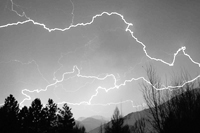At one time or another, most outdoorspeople in the Wood River Valley have probably had to make a quick decision while recreating in the high country.
In the sky overhead, large and ominous thunderheads are building. Pretty soon, a few errant lightning bolts are spotted hitting a ridgetop or two away, followed only seconds later by the loud clap of thunder.
These violent storms can be especially frightening to someone caught out in the open in the mountains, whether hiking, mountain biking or hunting.
In any given year, lightning strikes more than 400 people in the United States, according to the National Weather Service. During the past 30 years, lightning killed an average of 58 people per year. Neither tornadoes nor hurricanes kill as many people.
Research by the agency has shown that men are struck far more often than women, sustaining about 85 percent of all lightning deaths. Men under 40 years old account for 60 percent of all lightning fatalities, the agency states.
So far in 2009, 22 people have been killed by lightning in the United States. Across Idaho, there were 26 lightning fatalities reported between 1959 and 2008. By far the most dangerous lightning spot in the nation is the Southeast, with Florida topping the list with 455 fatalities since 1959.
Deciding what to do when lightning threatens depends on your location.
The best option is to head indoors if lightning threatens. A safe building is fully enclosed with a roof, walls and floor, and has plumbing or wiring.
But if a safe vehicle or building is not available—a common occurrence in Idaho's backcountry—avoid open fields, the tops of hills or any ridgetop. Keep away from tall, isolated trees and other tall objects. When in a forest, stay near a lower or more even-aged stand of trees. If camping in the open, set up camp in a valley or other low area. Tents offer no protection from lighting.
When lightning is near, people should stay away from water, wet items, such as ropes, and metal objects, such as fences and poles. Water and metal are excellent conductors of electricity. The current from a lightning flash will easily travel for long distances.
According to one of the ultimate guides to traveling safely in the high country, "The Freedom of the Hills," hikers, climbers and other outdoorspeople can actually gauge the movement of a thunderstorm by using the "flash and bang" principle.
Right when the lightning flashes, start counting the seconds, the book advises. Stop timing when the sound of thunder is heard. Divide the number of seconds by five, the book states and you'll get the thunderstorm's distance away in miles. To determine if the thunderstorm is moving closer, continue timing lightning and thunder discharges to judge if the storm is approaching, holding in place or retreating.
Other tips to remember if a lightning storm threatens and no safe building exists nearby include insulating oneself from the ground with items such as a pack or foam pad, crouching to minimize one's profile and never lying flat on the ground, which can allow for better electrical conduction.
Our nation's love of outdoor activities and the frequency of summer thunderstorms make the warm season the most likely time to be injured or killed by lightning, according to statistics compiled by the National Weather Service. More than 70 percent of lightning fatalities occur between June and August, said John Jensenius, a lightning expert who tracks and evaluates lightning deaths for the agency.
In the end, knowing the weather patterns of your area may be the best way to avoid becoming a lightning statistic. For example, in mountainous areas such as south-central Idaho, thunderstorms usually develop in the early afternoon, so plan to hike early in the day and be down to lower elevations by noon.
People should always make sure to listen to the weather forecast for an area before visiting, as forecasts can change from spot to spot.
Jason Kauffman: jkauffman@mtexpress.com


 Lightning can quickly turn a fun outing in the mountains into a life-and-death situation. The natural phenomenon has killed more than two-dozen people in Idaho since 1959.
Lightning can quickly turn a fun outing in the mountains into a life-and-death situation. The natural phenomenon has killed more than two-dozen people in Idaho since 1959.



































